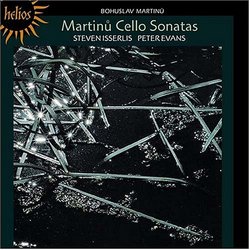| All Artists: Bohuslav Martinu, Peter Evans Title: Martinu: Cello Sonatas Members Wishing: 0 Total Copies: 0 Label: Hyperion UK Release Date: 11/9/2004 Album Type: Import Genre: Classical Styles: Chamber Music, Historical Periods, Classical (c.1770-1830), Instruments, Strings Number of Discs: 1 SwapaCD Credits: 1 UPC: 034571151854 |
Search - Bohuslav Martinu, Peter Evans :: Martinu: Cello Sonatas
CD Details |
CD ReviewsCZECH MATE DAVID BRYSON | Glossop Derbyshire England | 09/09/2007 (5 out of 5 stars) "Since ever I can remember, duo sonatas with piano have always been referred to as being for cello and piano, or violin and piano, or whatever and piano. Unless I am mistaken, the practice in classical times, ending only with Brahms's clarinet sonatas dating from the end of his career, was the other way about - piano and cello etc. This usage was a survival from very early days when duos were thought of as keyboard sonatas with some obbligato second instrument. As early as Mozart's time this did not describe the situation, although even Beethoven (more conservative than they often tell us) seems to have gone along with it without quibbling.
To some extent the piano had become an accompaniment, but with the best composers chamber duos were much more of a partnership of equals than any kind of poor man's concertos. The strenuous start of Martinu's first sonata puts the performers to a major test in establishing their respective status with the piano growling and the cello grunting in their respective low registers at full volume. It's less a sense of partnership than one of all-in wrestling, but if the performers are up to it then one starts with the sense that all may be well from there on. Isserlis and Peter Evans set off with no holds barred, and, sure enough, everything else goes well. Peter Evans is new to me, and the liner tells us nothing about him, but he has certainly aroused my interest this time and I shall be looking for his other work. Isserlis I have been familiar with for many years, and he presumably needs no introduction as one of the finest exponents of his instrument in his generation. The information in the liner-note is entirely about the composer and these three sonatas in particular, but the note is a distinctly good one, by Kenneth Dommett with a translation into German. I have to take Dommett's word for it about the extent of Czech idiom in the music, because my own idea of that idiom is Smetana and Dvorak, and to some extent Janacek, who do not sound much like this. The sonatas are not described as being in this or that key, but the musical idiom is tonal, albeit 20th century tonal. Indeed, the slow movement of the second sonata could easily be taken for 19th century romantic. Dommett touches in the biographical background to the works' genesis, but broadly I think it would be fair to say that they lighten up a bit as they go along, and it was no surprise to me to be told that the third is the most popular of the three. As with the performance, so with the recorded sound - if it copes well with that start to the first sonata it ought to have few or no problems thereafter, and the effect, from January 1988, gives me no problems at any point. This disc has real quality from every point of view, and I can recommend it thoroughly to newcomers to Martinu or to his sonatas, in which category I should probably place myself, for all the attention I had given them down the years. Experts may be more discriminating, but if any have significant faults to find with this admirable issue I shall be distinctly surprised." |

